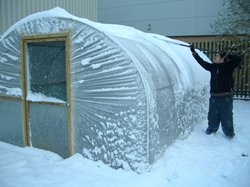Waking up to a fluffy, sparkly Winter wonderland in your garden may look lovely, but never underestimate the weight of snow and ice sitting on the roof of your polytunnel.
Although the UK weather can be unpredictable, heavy snow showers and very strong winds are not uncommon during the Winter months and even sometimes in early Spring.
February and March are busy, exciting months for polytunnel gardeners as they dare to look forward to Spring and begin to sow Summer crops. So, while you’re waiting for the snow to clear from your garden or allotment, why not take a look at our hints and tips below on how to protect your polytunnel when it snows and gets windy.
Polytunnel in Winter
 The weight of snow (even if it doesn’t look like a lot, it will weigh a lot!) can put strain on the polytunnel frame and may cause the polythene cover to stretch and sag if left to lie on the roof. Therefore, we recommend that snow is removed from the polytunnel as soon as possible. As the sun starts to become warmer and the daylight hours get longer, removing snow from your polytunnel will ensure as much light as possible enters the tunnel.
The weight of snow (even if it doesn’t look like a lot, it will weigh a lot!) can put strain on the polytunnel frame and may cause the polythene cover to stretch and sag if left to lie on the roof. Therefore, we recommend that snow is removed from the polytunnel as soon as possible. As the sun starts to become warmer and the daylight hours get longer, removing snow from your polytunnel will ensure as much light as possible enters the tunnel.
Some people may think that snow will act as an insulating layer for a polytunnel, however this is not the case – the snow will block any sunlight from entering the polytunnel, preventing the sun from warming the tunnel during daylight hours, slowing down the growth rate of your seedlings and plants.
Excess snow should be removed by tapping on the sides of the polytunnel cover and on the roof inside, encouraging the snow to dislodge and slide off. Use a soft brush to gently knock off snow from the roof and harder to reach areas – check out the video below of a customer using this method to clear his tunnel.
Snow on a Polytunnel
When a snowfall has covered your polytunnel, you could try these great hints and tips from our customers…
‘BELT AND BRACES’ METHOD – Tried, tested and recommended by a customer on the Shetland Isles – “In very heavy snowfall support the curved roof with timber struts inside the tunnel, positioned from the ground up to the centre of the hoops (excluding the end hoops)”.
“Use a gas or electric heater inside the tunnel to turn up the temperature and encourage the snow to slide off!” (Be careful not to point heat sources directly at the polythene).
Take a look at our recent blog post for more ideas on how to heat a polytunnel in winter.
Windbreak
Winter in the UK can be very wild and when the wind starts to pick up, we recommend securing your polytunnel by ensuring that door catches are fixed tight and that doors and side vents are secure. To prevent doors from rattling in gales, reinforce them with timber braces or a heavy weight.
During storms and strong winds, be on the lookout for flying debris or falling tree branches which may fall and puncture the polytunnel cover. Repair Tape is always handy to have on standby for those unforeseen mishaps.
Gardens and allotments in blustery, exposed locations often bear the brunt of strong winds which can damage crops and gardening equipment, and also reduce temperatures causing plant growth to slow down. To reduce the strength of the wind before it hits your plot and your polytunnel, consider installing a windbreak or shelterbelt.
Solid fences and barriers are not recommended for slowing down wind speed and gusts – Ideally, windbreaks should be semi-permeable, filtering at least 50% of the wind to reduce its strength. The green windbreak net that we supply provides 50% wind reduction and is ideal to be used as an artificial barrier to protect vulnerable plants, shrubs and polytunnels from gales.
The RHS has some great advice on living windbreaks and shelterbelts, including the types to choose from, dimensions and positioning of them.
For hints and tips on constructing a strong polytunnel that will stand the test of time, take a look at our Construction Advice.